Paying Comprehensive Attention to the Temperature-Dependent Dual-Channel Excited-State Intramolecular Proton Transfer Mechanism of Fluorescence Ratio Probe BZ-DAM
Abstract
:1. Introduction
2. Results and Discussion
2.1. Optimized Geometric Structure and Infrared (IR) Vibration Spectra
2.2. Absorption and Fluorescence Spectra
2.3. FMOs and Hole-Electron Analysis
2.4. Reduced Density Gradient (RDG) and HB Strength
2.5. Excited-State Proton Transfer Mechanism and Dynamic Simulation
3. Materials and Methods
4. Conclusions
Supplementary Materials
Author Contributions
Funding
Institutional Review Board Statement
Informed Consent Statement
Data Availability Statement
Conflicts of Interest
References
- Kavitha, V.; Viswanathamurthi, P.; Haribabu, J.; Echeverria, C. An aqueous mediated ultrasensitive facile probe incorporated with acrylate moiety to monitor cysteine in food samples and live cells. Spectrochim. Acta A Mol. Biomol. Spectrosc. 2023, 293, 122447. [Google Scholar] [CrossRef]
- Guo, W.; Ji, T.; Ma, Y.; Song, H.; Liu, J.; Dong, W. An amino-appended asymmetry salamo-type ratiometric fluorescent probe for efficient relay detection of B4O72−/HCHO in real samples. J. Mol. Struct. 2023, 1285, 135545. [Google Scholar] [CrossRef]
- Sagar, P.; Srivastava, M.; Tiwari, R.K.; Kumar, A.; Srivastava, A.; Pandey, G.; Srivastava, S. In-situ One-Pot Novel Synthesis of Molybdenum di-Telluride@Carbon Nano-Dots for Sensitive and Selective Detection of Hydrogen Peroxide Molecules via Turn-off Fluorescence Mechanism. Microchem. J. 2022, 183, 108134. [Google Scholar] [CrossRef]
- Wu, X.; Zhuang, H.; Yang, Y.; Guo, Q.; Shi, W. Insight into the probe BTFMB responses to hydrogen peroxide switching on ESIPT reaction. Chem. Phys. Lett. 2022, 807, 140067. [Google Scholar] [CrossRef]
- Qu, W.; Guo, T.; Yang, B.; Tian, R.; Qiu, S.; Chen, X.; Geng, Z.; Wang, Z. Tracking HOCl by an incredibly simple fluorescent probe with AIE plus ESIPT in vitro and in vivo. Spectrochim. Acta A Mol. Biomol. Spectrosc. 2022, 281, 121649. [Google Scholar] [CrossRef] [PubMed]
- Ahamed, S.; Mahato, M.; Tohora, N.; Sultana, T.; Sahoo, R.; Ghanta, S.; Das, S.K. A PET and ESIPT-communicated ratiometric, turn-on chromo-fluorogenic sensor for rapid and sensitive detection of sarin gas mimic, diethylchlorophosphate. Talanta 2023, 258, 124448. [Google Scholar] [CrossRef]
- Tohora, N.; Mahato, M.; Sultana, T.; Ahamed, S.; Das, S.K. A benzoxazole-based turn-on fluorosensor for rapid and sensitive detection of sarin surrogate, diethylchlorophosphate. Anal. Chim. Acta 2023, 1255, 341111. [Google Scholar] [CrossRef]
- Feng, B.; Wang, K.; Yang, Y.; Wang, G.; Zhang, H.; Liu, Y.; Jiang, K. Ultrasensitive recognition of AP sites in DNA at the single-cell level: One molecular rotor sequentially self-regulated to form multiple different stable conformations. Chem. Sci. 2019, 10, 10373–10380. [Google Scholar] [CrossRef]
- Liu, H.; Ma, C.; Wang, J.; Wang, K.; Wu, K. A turn-on fluorescent method for determination of the activity of alkaline phosphatase based on dsDNA-templated copper nanoparticles and exonuclease based amplification. Microchim. Acta 2017, 184, 2483–2488. [Google Scholar] [CrossRef]
- Zhu, D.; Rajalakshmi, K.; Wang, R.; Wu, H.; Kannan, P.; Song, J.-W.; Lee, H.-J.; Muthusamy, S. A coumarin derivative-based turn-on fluorescent probe for real-time applications of hydrazine detection in environment and bioimaging. Dye. Pigment. 2023, 216, 111370. [Google Scholar] [CrossRef]
- Tomczyk, M.M.; Przypis, Ł.; Shiraki, T.; Kusz, J.; Książek, M.; Janas, D.; Kuźnik, N. Surprising Solid-State ESIPT Emission from Apparently Ordinary Salicyliden Glycinates Schiff Bases. Int. J. Mol. Sci. 2022, 23, 14955. [Google Scholar] [CrossRef] [PubMed]
- Baranowska, K.; Mońka, M.; Bojarski, P.; Józefowicz, M. Insight into Molecular Interactions of Two Methyl Benzoate Derivatives with Bovine Serum Albumin. Int. J. Mol. Sci. 2021, 22, 11705. [Google Scholar] [CrossRef] [PubMed]
- Xie, J.H.; Wang, Z.Y.; Zhu, R.X.; Jiang, J.M.; Weng, T.-C.; Ren, Y.; Han, S.H.; Huang, Y.F.; Liu, W.M. Investigation of Excited-State Intramolecular Proton Transfer and Structural Dynamics in Bis-Benzimidazole Derivative (BBM). Int. J. Mol. Sci. 2023, 24, 9438. [Google Scholar] [CrossRef] [PubMed]
- Fan, K.W.; Luk, H.L.; Phillips, D.L. Anti-Kasha Behavior of 3-Hydroxyflflavone and Its Derivatives. Int. J. Mol. Sci. 2021, 22, 11103. [Google Scholar] [CrossRef]
- Ghosh, S.; Paul, S.; Halder, S.; Shit, M.; Karmakar, A.; Nandi, J.B.; Jana, K.; Sinha, C. Trace level CN− measurement by ‘turn-on’ emission using Coumarinyl-Benzothiazolyl Schiff base probe in living and non-living environment. J. Indian Chem. Soc. 2023, 100, 100957. [Google Scholar] [CrossRef]
- Wang, Q.; Li, X.; Song, L.; Zhao, J.; Tang, Z. Theoretical study on ESIPT mechanism and negative solvatochromism effect of 3-(4,5-Diphenyl-1H-imidazol-2-yl)-9-phenyl-9H-carbazol-4-ol compound in different solvents. J. Mol. Liq. 2023, 382, 122000. [Google Scholar] [CrossRef]
- Li, Y.; Sun, C.; Han, J.; Zhou, Q.; Cao, B.; Yin, H.; Shi, Y. Theoretical investigation of intermolecular hydrogen bond induces fluorescence quenching phenomenon for Coumarin-1. J. Lumin. 2020, 221, 117110. [Google Scholar] [CrossRef]
- Sun, C.; Zhang, X.; Diao, L.; Cao, B.; Yin, H.; Shi, Y. How the atomic electron-accepting ability affect the double ESIPT process of 2,5-bis(benzoxazol-2-yl)thiophene-3,4-diol? J. Lumin. 2020, 225, 117329. [Google Scholar] [CrossRef]
- Zhao, J.; Song, P.; Feng, L.; Wang, X.; Tang, Z. Theoretical insights into atomic-electronegativity-regulated ESIPT behavior for B-bph-fla-OH fluorophore. J. Mol. Liq. 2023, 380, 121763. [Google Scholar] [CrossRef]
- Zhao, J.; Dong, H.; Zheng, Y. Elaborating the excited state multiple proton transfer mechanism for 9H-pyrido[3,4-b]indole. J. Lumin. 2018, 195, 228–233. [Google Scholar] [CrossRef]
- Zhang, X.; Shen, L.-Y.; Zhang, Q.-L.; Yang, X.-J.; Huang, Y.-L.; Redshaw, C.; Xu, H. A Simple Turn-off Schiff Base Fluorescent Sensor for Copper (II) Ion and Its Application in Water Analysis. Molecules 2021, 26, 1233. [Google Scholar] [CrossRef] [PubMed]
- Mehta, R.; Kumar, S. ESIPT-based dual-emissive perimidine derivative as a rapid and sensitive sensor for Cu2+ and Al3+: Construction of memory device, 2-to-1 encoder and 1-to-2 decoder. Spectrochim. Acta A Mol. Biomol. Spectrosc. 2023, 293, 122471. [Google Scholar] [CrossRef] [PubMed]
- Kim, J.K.; Bong, S.Y.; Park, R.; Park, J.; Jang, D.O. An ESIPT-based fluorescent turn-on probe with isothiocyanate for detecting hydrogen sulfide in environmental and biological systems. Spectrochim. Acta A Mol. Biomol. Spectrosc. 2022, 278, 121333. [Google Scholar] [CrossRef] [PubMed]
- Pei, X.; Fang, Y.; Gu, H.; Zheng, S.; Bin, X.; Wang, F.; He, M.; Lu, S.; Chen, X. A turn-on fluorescent probe based on ESIPT and AIEE mechanisms for the detection of butyrylcholinesterase activity in living cells and in non-alcoholic fatty liver of zebrafish. Spectrochim. Acta A Mol. Biomol. Spectrosc. 2023, 287, 122044. [Google Scholar] [CrossRef]
- Shen, Y.; Liu, X.; Zhang, X.; Zhang, Y.; Gu, B. Employing an ICT-ESIPT strategy for ratiometric tracking of HClO based on sulfide oxidation reaction. Spectrochim. Acta A Mol. Biomol. Spectrosc. 2020, 239, 118515. [Google Scholar] [CrossRef]
- Das, M.K.; Mishra, T.; Guria, S.; Das, D.; Sadhukhan, J.; Sarker, S.; Dutta, K.; Adhikary, A.; Chattopadhyay, D.; Adhikari, S.S. Fluorometric detection of a chemical warfare agent mimic (DCP) using a simple hydroxybenzothiazole–diaminomaleonitrile based chemodosimeter. New J. Chem. 2023, 47, 250–257. [Google Scholar] [CrossRef]
- Zhao, J.; Jin, B.; Tang, Z. Solvent-polarity-dependent conformation and ESIPT behaviors for 2-(benzimidazol-2-yl)-3-hydroxychromone: A novel dynamical mechanism. Phys. Chem. Chem. Phys. 2022, 24, 27660–27669. [Google Scholar] [CrossRef]
- Shang, C.; Cao, Y.; Sun, C.; Li, Y. Tuning fluorescence behavior and ESIPT reaction of 2-(2-Hydroxy-phenyl)-4(3H)-quinazolinone by introducing different groups. J. Lumin. 2021, 235, 118059. [Google Scholar] [CrossRef]
- Zhang, Q.; Yang, Y.; Liu, Y. Theoretical insights into luminescence mechanism of Naphthyridine-based thermally activated delayed fluorescence emitter with aggregation-induced emission. Chem. Phys. Lett. 2023, 817, 140407. [Google Scholar] [CrossRef]
- Cao, Y.; Yu, X.; Sun, C.; Cui, J. Theoretical Investigation on the ESIPT Process and Detection Mechanism for Dual-Proton Type Fluorescent Probe. Int. J. Mol. Sci. 2022, 23, 2132. [Google Scholar] [CrossRef]
- Stasyuk, A.J.; Cyrański, M.K.; Gryko, D.T.; Solà, M. Acidic C–H bond as a proton donor in excited state intramolecular proton transfer reactions. J. Chem. Theory Comput. 2015, 11, 1046–1054. [Google Scholar] [CrossRef]
- Yang, Y.; Liu, Y.; Feng, B.; Zhang, H.; Qin, C.; Yu, K.; Jiang, K.; Liu, Y. Discerning the multi-color fluorescence in donor-π-acceptor molecules by femtosecond transient absorption spectroscopy. J. Lumin. 2022, 242, 118591. [Google Scholar] [CrossRef]
- Zhao, J.; Zhang, H.; Fan, L.; Li, F.; Song, P. Unveiling and regulating the solvent-polarity-associated excited state intramolecular double proton transfer behavior for 1-bis(benzothiazolyl)naphthalene-diol fluorophore. Spectrochim. Acta A Mol. Biomol. Spectrosc. 2023, 299, 122831. [Google Scholar] [CrossRef]
- Frisch, M.J.; Trucks, G.W.; Schlegel, H.B.; Scuseria, G.E.; Robb, M.A.; Cheeseman, J.R.; Scalmani, G.; Barone, V.; Petersson, G.A.; Nakatsuji, H. Gaussian 16; Gaussian, Inc.: Wallingford, CT, USA, 2016. [Google Scholar]
- Li, M.; Li, X.; Feng, L.; Zhao, J.; Jin, B. Insights into photo-induced excited state behaviors for 2-[4-(Di-tert-butyl-amino)-phenyl]-5-(5-fluoro-benzooxazol-2-yl)-benzofuran-6-ol: Solvent effects. Chem. Phys. Lett. 2023, 825, 140607. [Google Scholar] [CrossRef]
- Haroon, M.; Janjua, M.R.S.A. Exploring the effect of end-capped modifications of carbazole-based fullerene-free acceptor molecules for high-performance indoor organic solar cell applications. J. Comput. Electron. 2022, 21, 40–51. [Google Scholar] [CrossRef]
- Zhao, J.; Jin, B. Solvent polarity dependent excited state hydrogen bond effects and intramolecular double proton transfer mechanism for 2-hydroxyphenyl-substituted benzo[1,2-d:4,5-d’]bisimidazole system. Spectrochim. Acta A Mol. Biomol. Spectrosc. 2021, 250, 119394. [Google Scholar] [CrossRef] [PubMed]
- Jia, X.; Yang, Y.; Zhai, H.; Zhang, Q.; He, Y.; Liu, Y.; Liu, Y. The mechanisms of a bifunctional fluorescent probe for detecting fluoride and sulfite based on excited-state intramolecular proton transfer and intramolecular charge transfer. Struct. Dyn. 2021, 8, 034103. [Google Scholar] [CrossRef]
- Liu, S.; Qin, M.; Lu, Q.; Lin, L.; Wang, C.-K.; Fan, J.; Song, Y. Sensing mechanism of fluorescent sensor to Cu2+ based on inhibiting ultra-fast intramolecular proton transfer process. Spectrochim. Acta A Mol. Biomol. Spectrosc. 2021, 254, 119685. [Google Scholar] [CrossRef] [PubMed]
- Lan, X.; Yang, D.; Sui, X.; Wang, D. Time-dependent density functional theory (TD-DFT) study on the excited-state intramolecular proton transfer (ESIPT) in 2-hydroxybenzoyl compounds: Significance of the intramolecular hydrogen bonding. Spectrochim. Acta A Mol. Biomol. Spectrosc. 2012, 102, 281–285. [Google Scholar] [CrossRef] [PubMed]
- Li, C.; Li, D.; Ma, C.; Liu, Y. DFT-TDDFT investigation of excited-state intramolecular proton transfer in 2-(2′-hydroxyphenyl)benzimidazole derivatives: Effects of electron acceptor and donor groups. J. Mol. Liq. 2016, 224, 83–88. [Google Scholar] [CrossRef]
- Sun, C.; Su, X.; Zhou, Q.; Shi, Y. Regular tuning of the ESIPT reaction of 3-hydroxychromone-based derivatives by substitution of functional groups. Org. Chem. Front. 2019, 6, 3093–3100. [Google Scholar] [CrossRef]
- Nguyen, P.D.; Ding, F.; Fischer, S.A.; Liang, W.; Li, X. Solvated First-Principles Excited-State Charge-Transfer Dynamics with Time-Dependent Polarizable Continuum Model and Solvent Dielectric Relaxation. J. Phys. Chem. Lett. 2012, 3, 2898–2904. [Google Scholar] [CrossRef]
- Yin, H.; Li, B.; Zhao, X.; Liu, Y.; Shi, Y.; Ding, D. Restriction of intramolecular torsion induces abnormal blue-shifted fluorescence in the aggregate state. Dye. Pigment. 2022, 201, 110192. [Google Scholar] [CrossRef]
- Lu, T.; Chen, F. Multiwfn: A multifunctional wavefunction analyzer. J. Comput. Chem. 2012, 33, 580–592. [Google Scholar] [CrossRef]
- Johnson, E.R.; Keinan, S.; Mori-Sánchez, P.; Contreras-García, J.; Cohen, A.J.; Yang, W. Revealing Noncovalent Interactions. J. Am. Chem. Soc. 2010, 132, 6498–6506. [Google Scholar] [CrossRef]
- Humphrey, W.; Dalke, A.; Schulten, K. VMD: Visual molecular dynamics. J. Mol. Graph. 1996, 14, 33–38. [Google Scholar] [CrossRef]
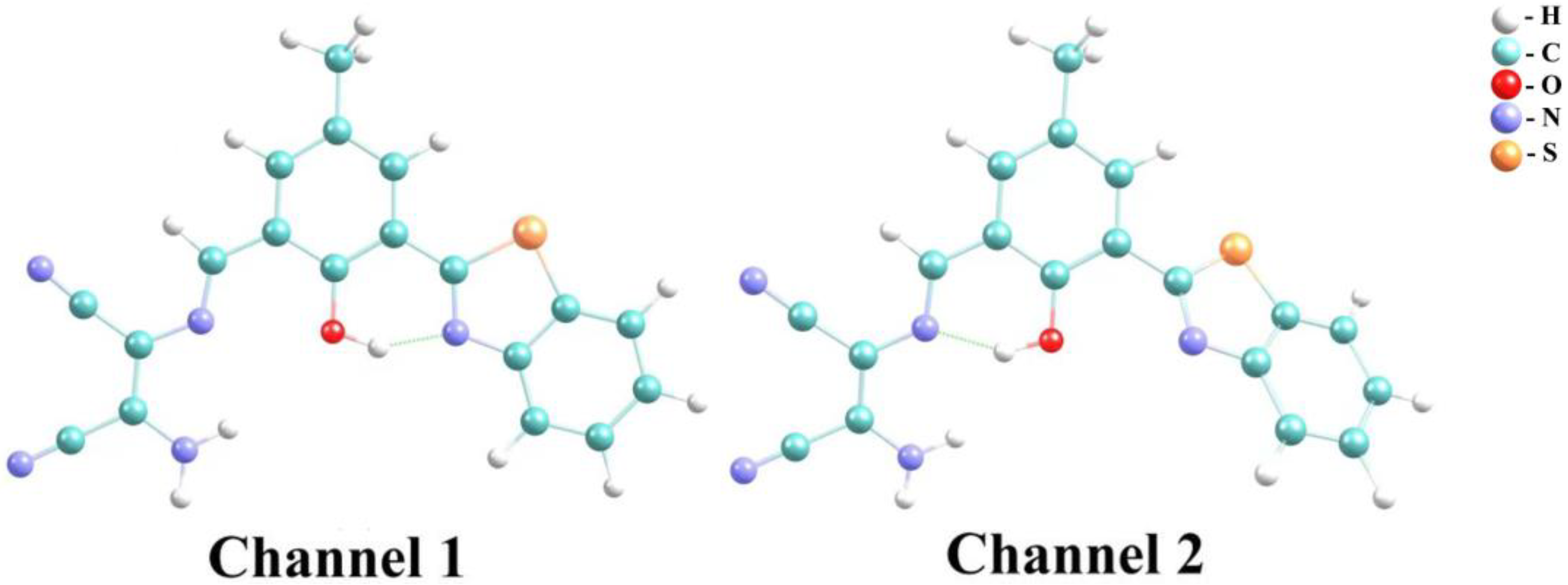
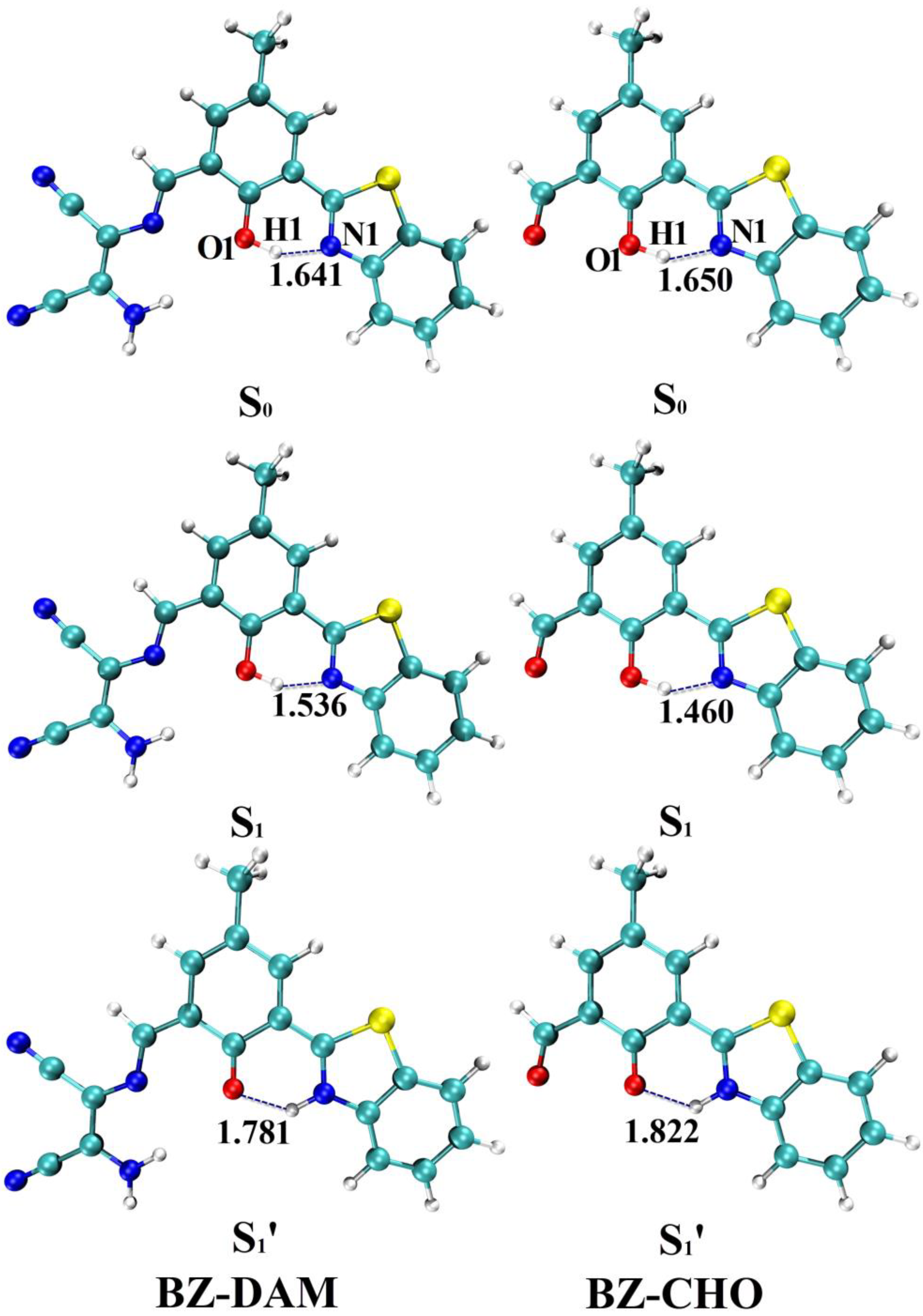

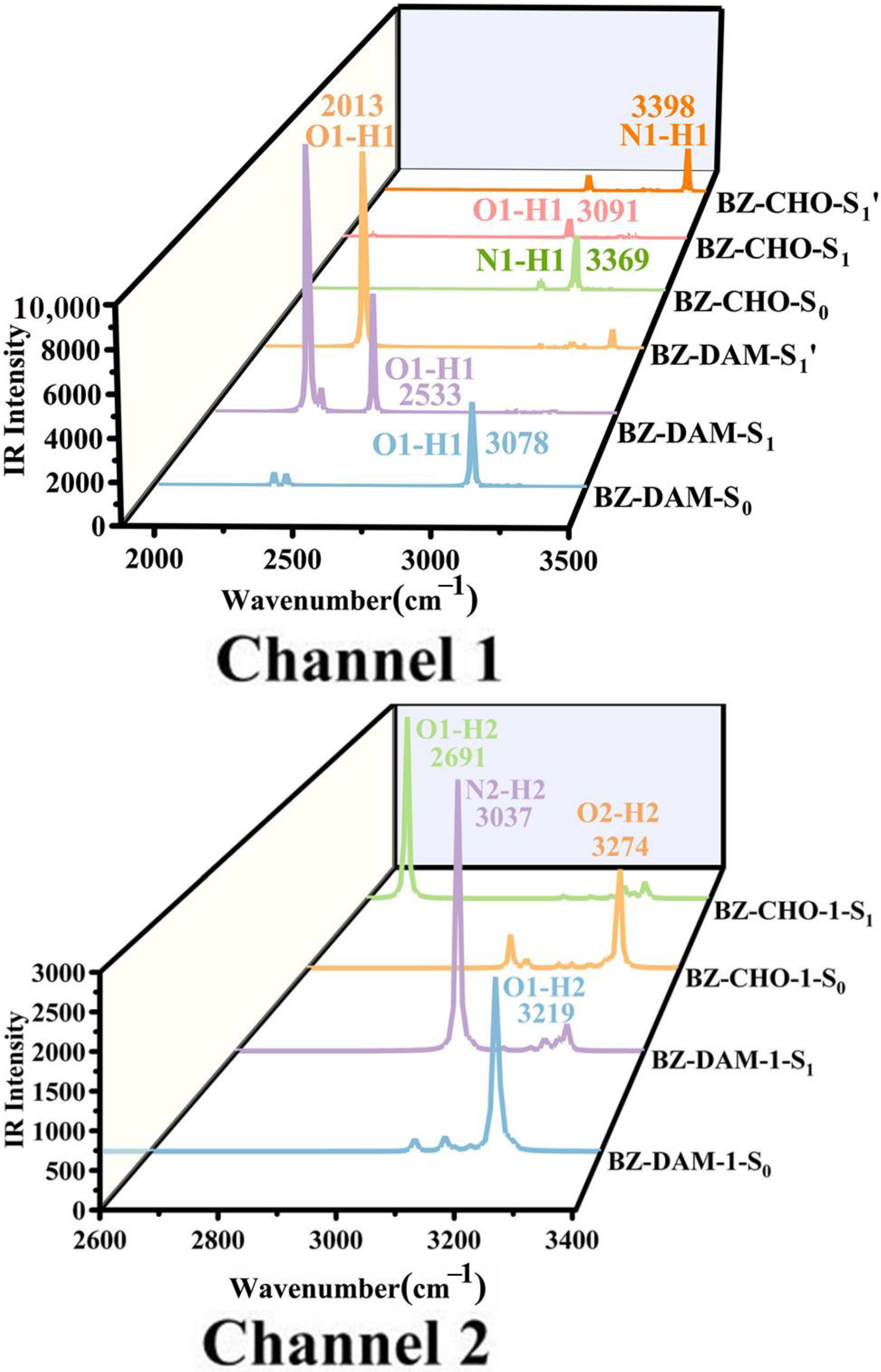

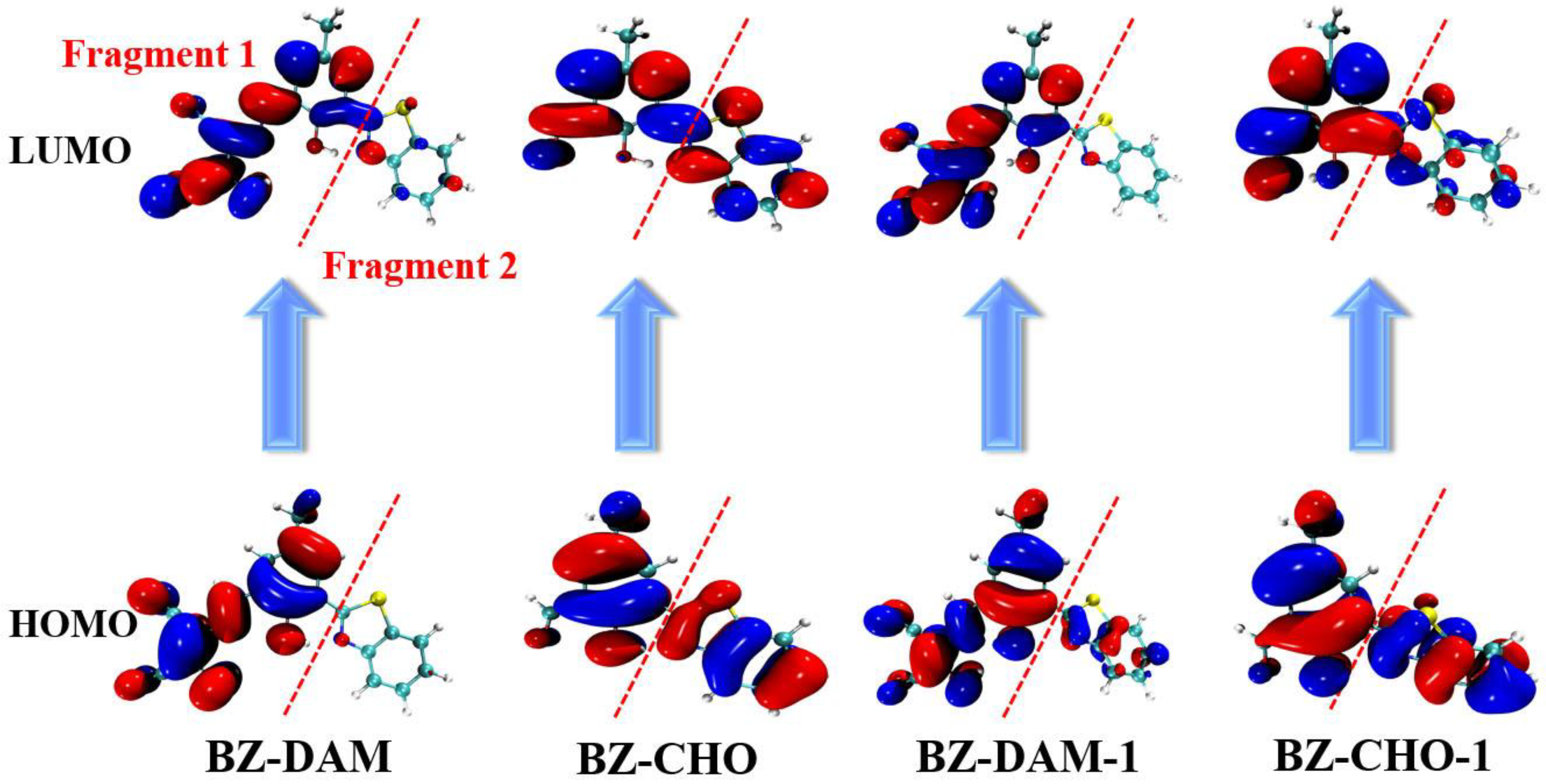
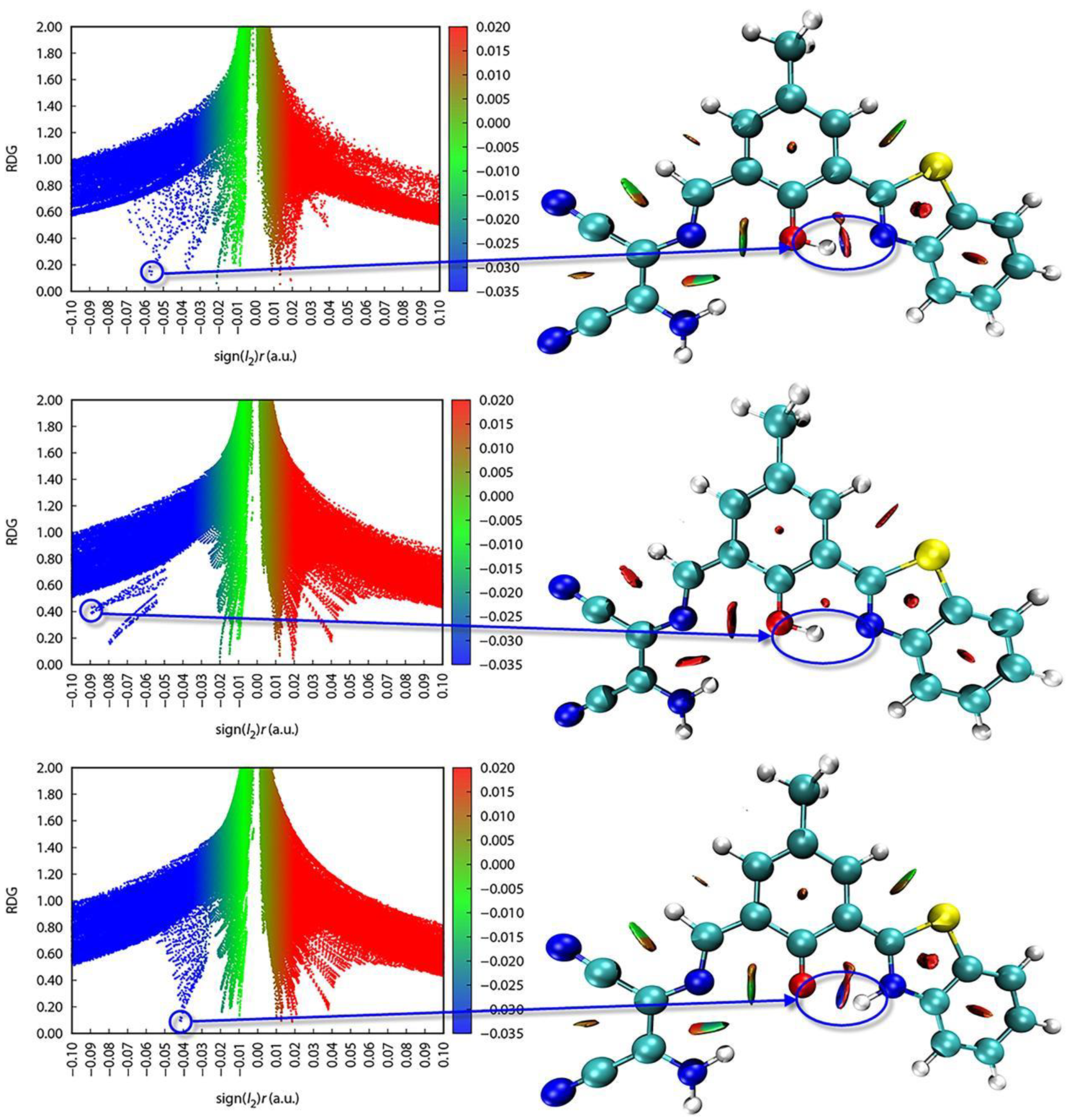
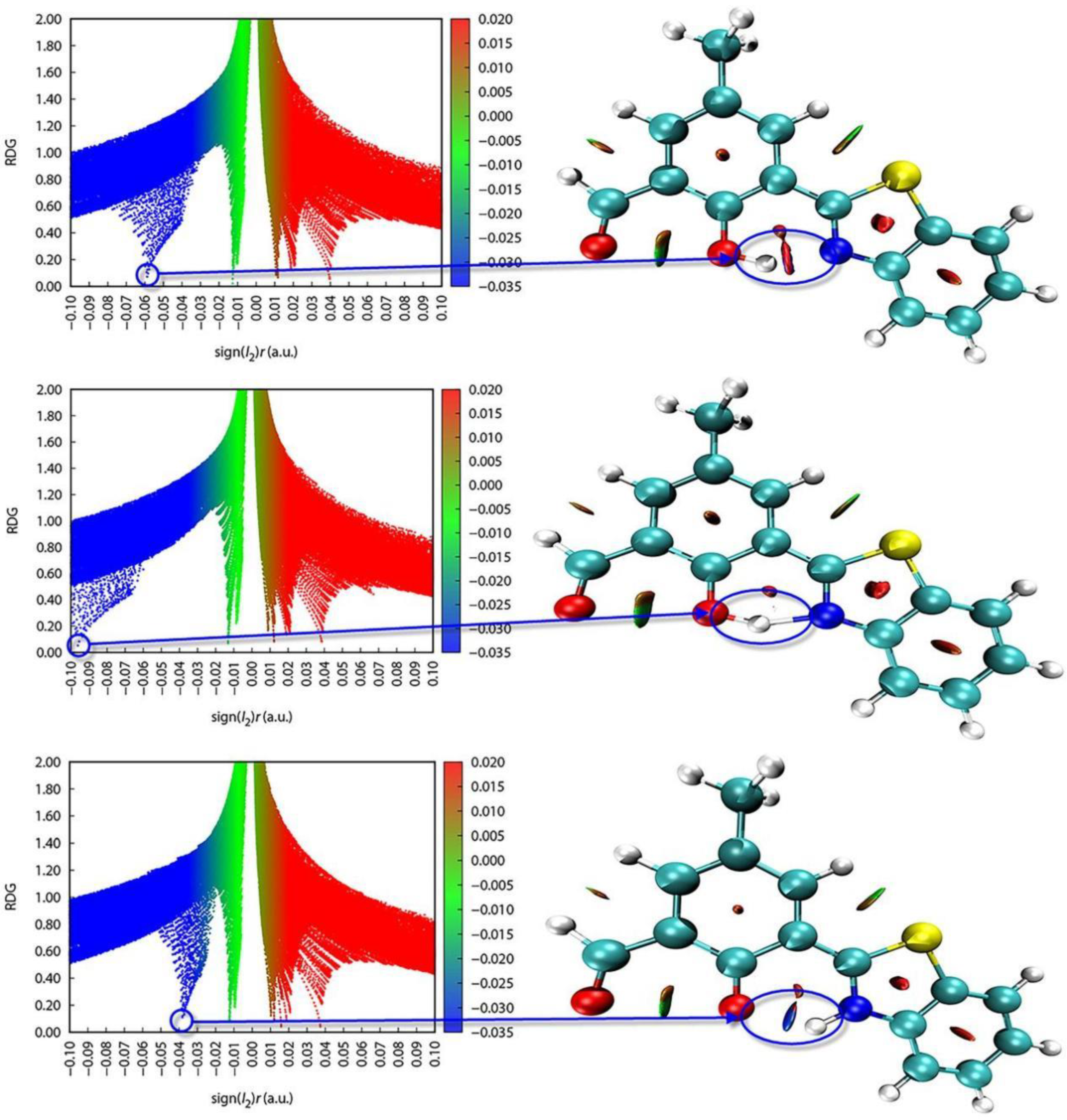


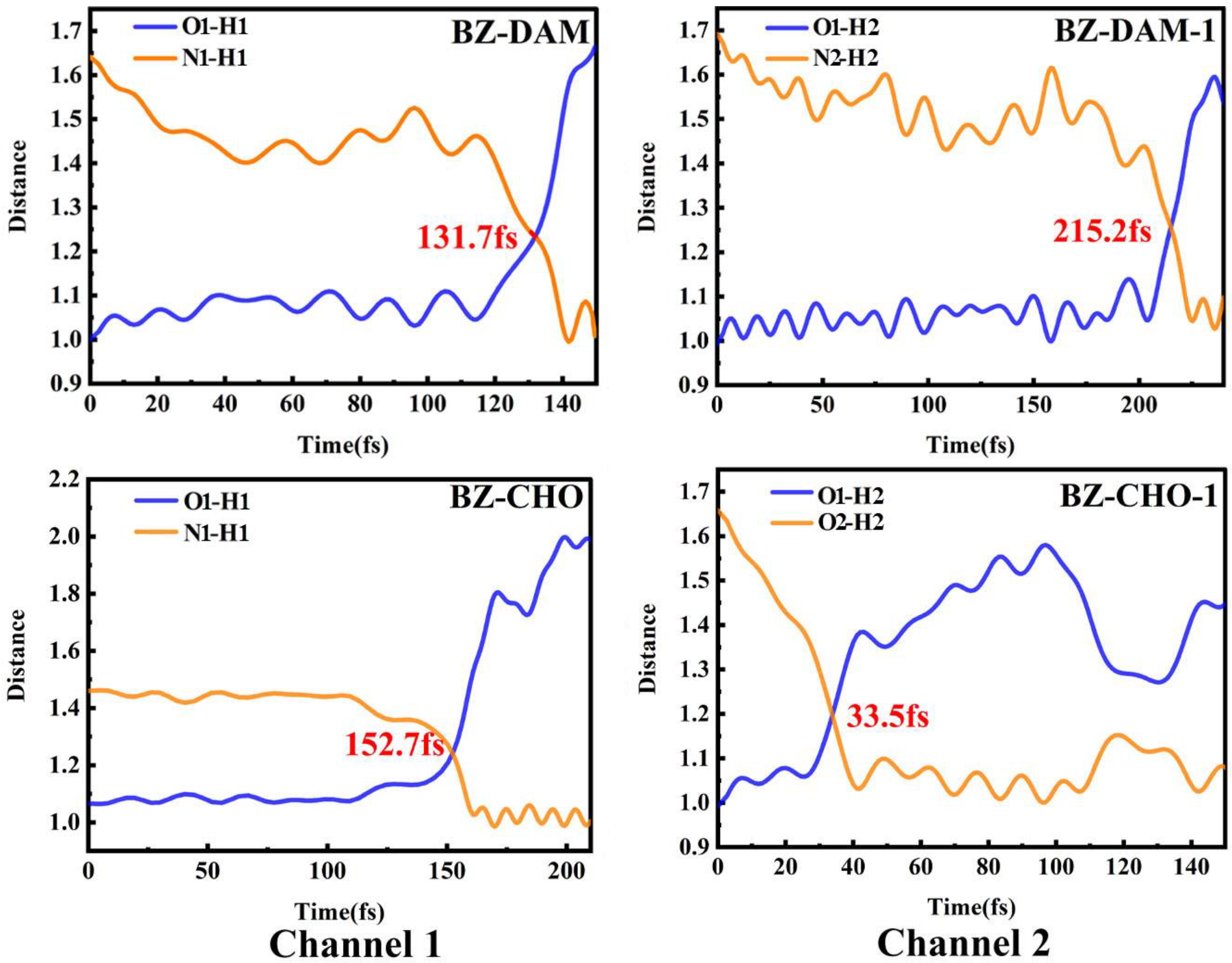
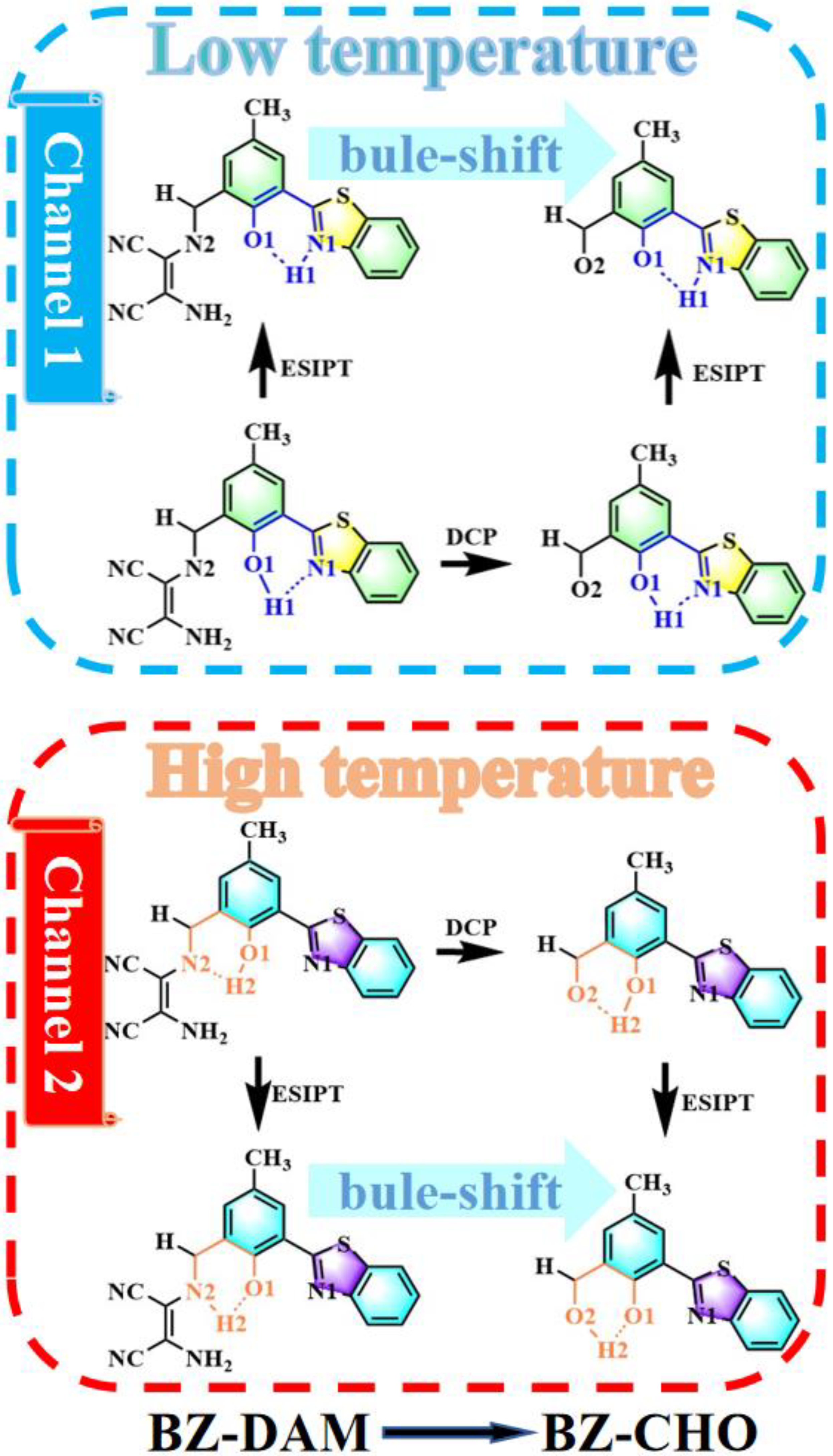
| BZ-DAM | BZ-CHO | |
|---|---|---|
| S0 S1 S1′ | S0 S1 S1′ | |
| O1-H1 | 1.001 1.030 1.781 | 1.000 1.066 1.822 |
| N1-H1 | 1.641 1.536 1.026 | 1.650 1.460 1.025 |
| σ(O1-H1-N1) | 150.06 151.75 132.25 | 149.67 153.14 131.12 |
| σ(C1-C2-C3-N1) | 0.01 0.00 −0.02 | 0.02 0.01 0.09 |
| BZ-DAM-1 | BZ-CHO-1 | |
| S0 S1 | S0 S1 | |
| N2-H2 | 1.658 1.047 | - - |
| O1-H2 | 0.992 1.670 | 0.992 1.509 |
| O2-H2 | - - | 1.658 1.028 |
| σ(O1-H2-O2) | 150.37 141.03 | 150.37 153.69 |
| σ(C1-C2-C3-N1) | −34.78 8.48 | 35.83 −3.68 |
| BZ-DAM | BZ-DAM-1 | BZ-CHO | BZ-CHO-1 | |
|---|---|---|---|---|
| 300 K | 98.09% | 1.91% | 88.38% | 11.62% |
| 400 K | 90.26% | 9.74% | 76.78% | 23.22% |
| 500 K | 75.84% | 24.16% | 66.43% | 33.57% |
| 600 K | 59.15% | 40.85% | 57.90% | 42.10% |
| 700 K | 44.54% | 55.46% | 51.06% | 48.94% |
| 800 K | 33.44% | 66.56% | 45.61% | 54.39% |
| 900 K | 25.39% | 74.61% | 41.22% | 58.78% |
| 1000 K | 19.75% | 80.25% | 37.64% | 62.36% |
| 2000 K | 4.02% | 95.98% | 21.26% | 75.74% |
| 3000 K | 1.78% | 98.22% | 15.72% | 84.28% |
| 4000 K | 1.04% | 98.96% | 12.40% | 87.60% |
| 5000 K | 0.70% | 99.30% | 11.05% | 88.95% |
| State | λflu (nm) | f | Lifetime (ns) | Rate (s−1) | ||
|---|---|---|---|---|---|---|
| channel 1 | BZ-DAM | S1 | 454.52 | 0.7166 | 4.32 | 2.31 × 108 |
| BZ-DAM | S1′ | 585.87 | 0.8040 | 6.40 | 1.56 × 108 | |
| BZ-CHO | S1 | 406.26 | 0.7400 | 3.34 | 2.99 × 108 | |
| BZ-CHO | S1′ | 309.68 | 0.4493 | 3.20 | 3.13 × 108 | |
| channel 2 | BZ-DAM-1 | S1 | 662.12 | 0.3600 | 18.25 | 5.48 × 107 |
| BZ-CHO-1 | S1 | 545.26 | 0.3652 | 12.23 | 8.18 × 107 |
| Fragment 1 | Fragment 2 | Δ | O1 | N1 | O2 | N2 | ||
|---|---|---|---|---|---|---|---|---|
| BZ-DAM | HOMO | 95.88 | 4.12 | 91.76 | 6.40 | 0.37 | - | - |
| LUMO | 92.63 | 7.37 | - | 0.54 | 1.39 | - | - | |
| BZ-CHO | HOMO | 65.87 | 34.13 | 31.74 | 11.79 | 4.47 | - | - |
| LUMO | 59.96 | 40.04 | - | 0.22 | 8.52 | - | - | |
| BZ-DAM-1 | HOMO | 92.85 | 7.15 | 85.70 | 9.23 | - | - | 6.19 |
| LUMO | 97.81 | 2.19 | - | 1.48 | - | - | 6.86 | |
| BZ-CHO-1 | HOMO | 60.70 | 39.30 | 21.40 | 10.48 | - | 0.77 | - |
| LUMO | 75.08 | 24.92 | - | 1.55 | - | 14.85 | - |
| B3LYP | CAM-B3LYP | M06-2X | MPW1PW91 | MN15 | PBE | Exp. | |
|---|---|---|---|---|---|---|---|
| λabs | 323,414 | 308,352 | 306,350 | 310,397 | 322,369 | 419,520 | 311,400 |
| ρ(r) | V(r) | G(r) | K(r) | EHB | |
|---|---|---|---|---|---|
| BZ-DAM | 0.06040 | −0.05027 | 0.04152 | 0.00875 | −12.732 |
| BZ-DAM | 0.07882 | −0.07533 | 0.05280 | 0.02253 | −16.841 |
| BZ-DAM | 0.04169 | −0.03308 | 0.03190 | 0.00118 | −8.558 |
| BZ-CHO | 0.05920 | −0.04872 | 0.04061 | 0.00812 | −12.464 |
| BZ-CHO | 0.09611 | −0.10287 | 0.06095 | 0.04193 | −20.698 |
| BZ-CHO | 0.03832 | −0.03015 | 0.02903 | 0.00112 | −7.806 |
| BZ-DAM-1 | 0.01180 | −0.00898 | 0.00974 | −0.00076 | −1.890 |
| BZ-DAM-1 | 0.05359 | −0.04343 | 0.03988 | 0.03550 | −11.213 |
| BZ-CHO-1 | 0.05278 | −0.04391 | 0.04065 | 0.00326 | −11.032 |
| BZ-CHO-1 | 0.01438 | −0.01088 | 0.01135 | −0.00047 | −2.466 |
Disclaimer/Publisher’s Note: The statements, opinions and data contained in all publications are solely those of the individual author(s) and contributor(s) and not of MDPI and/or the editor(s). MDPI and/or the editor(s) disclaim responsibility for any injury to people or property resulting from any ideas, methods, instructions or products referred to in the content. |
© 2023 by the authors. Licensee MDPI, Basel, Switzerland. This article is an open access article distributed under the terms and conditions of the Creative Commons Attribution (CC BY) license (https://creativecommons.org/licenses/by/4.0/).
Share and Cite
Gao, J.; Zhang, Y.; Mu, H.; Yang, M.; Guan, X.; Jin, G.; Li, H. Paying Comprehensive Attention to the Temperature-Dependent Dual-Channel Excited-State Intramolecular Proton Transfer Mechanism of Fluorescence Ratio Probe BZ-DAM. Int. J. Mol. Sci. 2023, 24, 13899. https://doi.org/10.3390/ijms241813899
Gao J, Zhang Y, Mu H, Yang M, Guan X, Jin G, Li H. Paying Comprehensive Attention to the Temperature-Dependent Dual-Channel Excited-State Intramolecular Proton Transfer Mechanism of Fluorescence Ratio Probe BZ-DAM. International Journal of Molecular Sciences. 2023; 24(18):13899. https://doi.org/10.3390/ijms241813899
Chicago/Turabian StyleGao, Jiaan, Yifu Zhang, Hongyan Mu, Min Yang, Xiaotong Guan, Guangyong Jin, and Hui Li. 2023. "Paying Comprehensive Attention to the Temperature-Dependent Dual-Channel Excited-State Intramolecular Proton Transfer Mechanism of Fluorescence Ratio Probe BZ-DAM" International Journal of Molecular Sciences 24, no. 18: 13899. https://doi.org/10.3390/ijms241813899
APA StyleGao, J., Zhang, Y., Mu, H., Yang, M., Guan, X., Jin, G., & Li, H. (2023). Paying Comprehensive Attention to the Temperature-Dependent Dual-Channel Excited-State Intramolecular Proton Transfer Mechanism of Fluorescence Ratio Probe BZ-DAM. International Journal of Molecular Sciences, 24(18), 13899. https://doi.org/10.3390/ijms241813899





